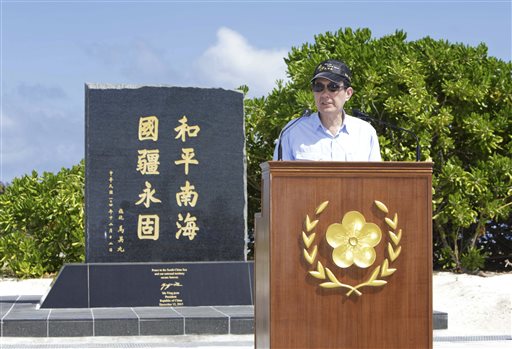
In this Jan. 28, 2016 file photo released by the Taiwan Presidential Office, Taiwan’s President Ma Ying-jeou speaks during his visit to Taiping Island, also known as Itu Aba, in the Spratly archipelago, south of Taiwan. Taiwan flew international media to Taiping, its largest island holding in the South China Sea, on Wednesday, March 23, in a bid to reinforce its territorial claims in the disputed and increasingly tense region. The letters on the monument dedicated by Ma on Dec. 12, 2015, read: “Peace in the South China Sea and our national security forever.” (Taiwan Presidential Office via AP, File)
TAIPING ISLAND — Taiwan flew international media to its largest island holding in the South China Sea on Wednesday in a bid to reinforce its territorial claims in the disputed and increasingly tense region.
Deputy Foreign Minister Bruce Linghu, who was leading the trip, said he intended to demonstrate that Taiping is an island capable of sustaining human habitation, and not simply a “rock” as the Philippines claims in a case brought before the Permanent Court of Arbitration. Islands are entitled to territorial waters, an exclusive economic zone and other rights not enjoyed by mere rocks.
Two dozen journalists were flown to the island aboard a Taiwanese air force C-130 transport plane that landed on an airstrip on Taiping guarded by coast guard sentries with rifles. They were shown the island’s post office and its fresh water well, and were to later visit the harbor and a traditional Chinese temple.
The Philippines, along with Vietnam, also claims Taiping. Critics say Manila is seeking to have Taiping designated a rock to avoid having to share an exclusive economic zone with its own nearby island of Palawan.
The Philippines “distorted the facts and misinterpreted the law” in its arguments, Linghu told reporters at a pre-trip briefing Tuesday in Taipei, Taiwan’s capital.
Manila’s case, which has been rejected by China, aims to challenge Beijing’s blanket claim to virtually the entire South China Sea. Yet it threatens also to harm relations between the Philippines and fellow pro-U.S. democracy Taiwan.
Taiwan, which lacks diplomatic ties to negotiate with the five other governments with territorial claims in the South China Sea, has increasingly turned to public diplomacy to reinforce its own claims.
Taiwanese President Ma Ying-jeo paid a visit to Taiping in late January, drawing rare criticism from the United States, Taiwan’s key ally, which has urged all parties to avoid steps that might raise tensions. Although Taiwan’s claim to almost the entire region overlaps with China’s, Ma has sought to cast Taiwan as a peaceful, humanitarian player in the region.
Taiwan operates a 10-bed hospital, a lighthouse and a fishing industry aid station on 46-hectare (110-acre) Taiping, also known as Itu Aba, which has a population of around 200 mostly coast guard personnel. It is spending more than $100 million to upgrade the island’s airstrip and build a wharf capable of allowing its 3,000-ton coast guard cutters to dock.
Roughly 2,000 kilometers (1,200 miles) south of Taiwan, Taiping is the largest naturally occurring island in the South China Sea’s disputed Spratly Islands.
However, it has recently been eclipsed in size by artificial islands China has built by piling sand on top of reefs and shoals, and then constructing housing, ports, airstrips and other infrastructure. The United States and others say Beijing is exacerbating tensions in the strategically vital region, while China accuses the U.S. of militarizing the area by ordering Navy ships to cruise in defiance of Beijing’s claims.
Malaysia and Brunei also say parts of the strategically vital sea belong to them. The dispute now threatens to draw in Indonesia, whose sea border abuts China’s vague, unilaterally declared boundary around the South China Sea known as the nine-dash line.
Indonesia this week detained the eight crew members of a Chinese vessel it accused of fishing illegally in its waters, while China says the ship was being “harassed” by an armed Indonesian government boat.
RELATED STORIES
South China Sea’s vague 9-dash line underpins China’s claim
China to establish international maritime judicial center
RELATED VIDEOS